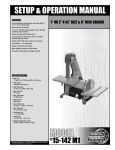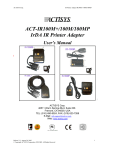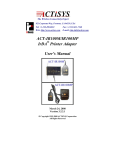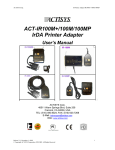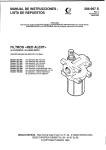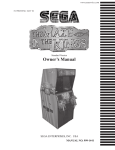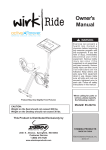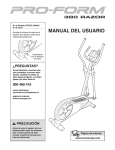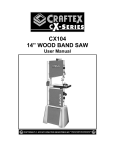Download General International 15-232 M1 Use and Care Manual
Transcript
Double sealed ball bearing construction. Adjustable aluminium tool rest. Flexible “gooseneck” style work light. Quick change belt tension lever facilitates fast belt changes. Belt sander operates horizontally and vertically and can be locked at any angle in between. Perfect for knife honing and sharpening or general shop use. 3450 RPM grinder speed to handle just about any metal grinding application and 4900 FPM belt speed for sanding both hard and soft woods. 1- 60 grit sanding belt & grinding wheel included. BELT SIZE 1 3⁄4” x 31 7⁄ ” 8 (44 x 810 mm) WHEEL SIZE 6” x 3⁄4” x 1⁄2” (152 x 19 x 13 mm) BELT SPEED 4900 FPM (1500 M/MIN) GRINDER SPEED 3450 RPM MOTOR 1⁄ HP, 120 V, 3.7 A 3 WEIGHT 33 LBS (15 kg) REVISION 2 OCTOBER 17/06 GENERAL® INTERNATIONAL 8360 Champ-d’Eau, Montreal (Quebec) Canada H1P 1Y3 Telephone (514) 326-1161 • Fax (514) 326-5555 www.general.ca THANK YOU for choosing this General® International model 15-232 Belt sander / grinder. This Belt sander / grinder has been carefully tested and inspected before shipment and if properly used and maintained, will provide you with years of reliable service. To ensure optimum performance and trouble-free operation, and to get the most from your investment, please take the time to read this manual before assembling, installing and operating the unit. The manual’s purpose is to familiarize you with the safe operation, basic function, and features of this Belt sander / grinder as well as the set-up, maintenance and identification of its parts and components. This manual is not intended as a substitute for formal woodworking instruction, nor to offer the user instruction in the craft of woodworking. If you are not sure about the safety of performing a certain operation or procedure, do not proceed until you can confirm, from knowledgeable and qualified sources, that it is safe to do so. Once you’ve read through these instructions, keep this manual handy for future reference. GENERAL ® INTERNATIONAL WARRANTY All component parts of General® International machinery are carefully tested and inspected during all stages of production, and each machine is thoroughly inspected upon completion of assembly. Because of our commitment to quality and customer satisfaction, General® International agrees to repair or replace, within a period of 24 months from date of purchase, any genuine part or parts which, upon examination, prove to be defective in workmanship or material. In order to obtain this warranty, all defective parts must be returned freight pre-paid to General® International Mfg. Co., Ltd. Repairs attempted without our written authorization will void this warranty. Disclaimer: The information and specifications in this manual pertain to the unit as it was supplied from the factory at the time of printing. Because we are committed to making constant improvements, General® International reserves the right to make changes to components, parts or features of this unit as deemed necessary, without prior notice and without obligation to install any such changes on previously delivered units. Reasonable care is taken at the factory to ensure that the specifications and information in this manual corresponds with that of the unit with which it was supplied. However, special orders and “after factory” modifications may render some or all information in this manual inapplicable to your machine. Further, as several generations of this belt sander / grinder and several versions of this manual may be in circulation, if you own an earlier or later version of this unit, this manual may not depict your machine exactly. If you have any doubts or questions contact your retailer or our support line with the model and serial number of your unit for clarification. Rules for Safe Operation To help ensure safe operation, please take a moment to learn the machine’s applications and limitations, as well as potential hazards. General® International disclaims any real or implied warranty and hold itself harmless for any injury that may result from the improper use of it’s equipment. 1. Make sure that the operator has been properly trained and has read, and understands, the owners’ manual before operating any machinery. 2. Do not operate this belt sander / bench grinder when tired, distracted or under the effects of drugs, alcohol or any medication that impairs reflexes or alertness. 3. Keep the work area well lit, clean and free of debris or clutter. 4. Keep children and visitors at a safe distance; do not permit them to operate the unit. 5. Childproof and tamper proof your shop and all machinery with locks, master electrical switches and switch keys, to prevent unauthorized or unsupervised use. 6. Stay alert! Give your work your undivided attention. Even a momentary distraction can lead to serious injury. 7. Do not wear loose clothing, gloves, bracelets, necklaces or other jewelry while operating machinery. Wear protective hair covering to contain long hair and wear non-slip footwear. 8. Fine particulate dust is a carcinogen that can be hazardous to health. Work in a well ventilated area and wear eye, ear and respiratory protection devices. 9. Keep hands and other body parts well away from the sanding belt and grinding wheel and all other moving parts. Do not clear grinding or sanding dust away with hands, use a brush. 10. Make sure the sanding belt and grinding wheel are running at full operating speed before sanding or grinding. 11. Do not force the sanding belt or grinding wheel or push too hard. The unit will perform better, safer and more effectively at the speed or rate for which it was designed. 12. Never leave the power on or the machine running while it is unattended. 13. Use recommended speed grinding wheels, accessories, and work piece material. 14. Never stand or lean on the machine. Serious injury could occur if the unit is tipped or if unintentional contact is made with its’ moving parts. 15. Before starting the unit, make sure the grinding wheel is securely installed and tight to the arbor shaft. 16. Keep all guards and safety devices in place and in good working order. If a guard must be removed for maintenance or cleaning make sure it is properly re-installed before using the machine again. 17. Before performing any maintenance, repairs or adjustments including belt or wheel changes, make sure the power is off and the unit is unplugged. 18. Before plugging in and turning on the power, make sure that any adjustment tools, keys or wrenches have been removed and safely stored. 19. Always, make sure that switch is in "OFF" position before plugging in the power cord. 20. Only use accessories that are made or designed for this machine. The use of parts or accessories that are not recommended by General® International will void any warranty claims and may result in injury. 21. Make sure the machine is properly grounded. This unit is supplied with a three-prong electric plug; it should be plugged into a three-pole electrical receptacle. Never remove the third prong. 22. Do not use this belt sander / bench grinder for any purpose other than it’s intended use. If used for other purposes, General® International disclaims any real or implied warranty and holds itself harmless for any injury which may result from such use. Additional Safety Instructions for Bench Grinders Because each shop situation is unique, no list of safety guidelines can ever be complete. The most important safety feature in any shop is the knowledge and good judgement of the user. Use common sense and always keep safety considerations, as they apply to your individual shop situation first and foremost in mind. If you have any doubts about the safety of an operation you are about to perform: STOP! Do not perform the operation until you have validated from qualified individuals if the operation is safe to perform and what is the safest method to perform it. 1. LIMIT EXPOSURE TO DUST Some dust created by power sanding, sawing, grinding, drilling and similar operations contains chemicals known to the state of California to cause cancer, birth defects or other reproductive harm. Some examples include: • Lead from lead-based paint. • Crystalline silica from bricks, cement and other masonry products. • Arsenic and chromium from chemically treated lumber. Your risk from these exposures varies depending on how often you do this types of work. To reduce your exposure to these chemicals, work in a well ventilated area and work with approved safety equipment such as dust masks that are specially designed to filter out microscopic particles. 2. ALWAYS USE EYESHIELDS, WHEEL GUARDS AND SPARK GUARDS The supplied eye shields, wheel guards and spark guards should be maintained, properly installed on the unit and used at all times. 3. REPLACE DAMAGED PARTS OR COMPONENTS IMMEDIATELY Damaged parts or components may lead to a hazardous situation that could cause serious injury. Replace any damaged parts or components before operating the unit. 4. INSPECT GRINDING WHEELS BEFORE EACH USE Handle grinding wheels carefully. A damaged or chipped grinding wheel can discharge debris towards the operator at high speeds. Before installing or replacing a grinding wheel as well as before each use, take a moment to inspect the grinding wheel(s) for cracks, chips or other visible signs of damage. Do not use a damaged wheel. Tighten the spindle nut enough to hold the grinding wheel firmly but do not over tighten as excessive clamping force can damage the wheel. Use only the wheel flanges provided with the grinder and do not remove the blotter or label on either side of the grinding wheel. When replacing a grinding wheel select only wheels that are rated to a higher maximum R.P.M. than the maximum of the Bench Grinder. 5. ADJUST TOOL RESTS AND SPARK GUARDS AS NEEDED The diameter of the grinding wheels will decrease with use. Adjust the tools rests and sparks guards accordingly to maintain a distance of 1/16” from the wheel. 6. DO NOT STAND IN FRONT OF THE BENCH GRINDER DURING START-UP To avoid potential injury caused by debris ejected from a damaged wheel, stand to one side of the Bench Grinder when starting the unit. While standing to the side, turn the unit on, wait one minute until the unit comes up to full speed before grinding. 7. DO NOT OPERATE IN THE VICINITY OF FLAMMABLE MATERIALS Bench grinders will produce sparks and debris during grinding. Be sure to keep flammable materials from the immediate vicinity. Be sure to clean the grinding dust from the back of the Bench Grinder frequently. 8. DO NOT FORCE THE WORKPIECE AGAINST THE GRINDING WHEEL Excessive force especially to a cold grinding wheel may damage the wheel and create a dangerous situation. Apply the workpiece against the wheel slowly and use firm, steady even pressure. Do not grind against the sides of the grinding wheel and do not apply coolant direct to the grinding wheel. 9. KEEP ALL WHEEL GUARDS IN PLACE Do not use the bench grinder with the wheel guards removed. 10. KEEP THE TOOL RESTS FIRMLY TIGHTENED Inspect and re-tighten tools rests before each use. 11. USE THE SUPPLIED WHEEL DRESSER Always use the supplied wheel dresser to resurface the face of the grinding wheel. 12. WEAR APPROVED EYE PROTECTION Any power tool can throw foreign objects into the eyes of the user or of those nearby. Always wear safety goggles (not glasses) that comply with ANSI safety standard Z87.1 Everyday eyeglasses have only impact resistant lenses, they are not safety goggles. NOTES: Glasses or goggles not in compliance with ANSI Z87.1 could result in serious injury. ELECTRICAL REQUIREMENTS GROUNDING INSTRUCTIONS IN THE EVENT OF A MALFUNCTION OR BREAKDOWN, grounding provides a path of least resistance for electric current and reduces the risk of electric shock. This tool is equipped with an electric cord that has an equipment-grounding conductor and a grounding plug. The plug MUST be plugged into a matching receptacle that is properly installed and grounded in accordance with ALL local codes and ordinances. DO NOT MODIFY THE PLUG PROVIDED. If it will not fit the receptacle, have the proper receptacle installed by a qualified electrician. This tool is intended for use on a circuit that has a receptacle like the one illustrated in Figure . Figure shows a 3-prong electrical plug and receptacle that has a grounding conductor. If a properly grounded receptacle is not available, an adapter (Figure ) can be used to temporarily connect this plug to a 2-contact grounded receptacle. The temporary adapter should be used only until a properly grounded receptacle can be installed by a qualified technician. The adapter (Figure ) has a rigid lug extending from it that MUST be connected to a permanent earth ground, such as a properly grounded receptacle box. The Canadian Electrical Code prohibits the use of the adapters - check your local codes. IMPROPER CONNECTION of the equipment-grounding conductor can result in risk of electric shock. The conductor with green insulation (with or without yellow stripes) is the equipment-grounding conductor. If repair or replacement of the electric cord or plug is necessary, DO NOT connect the equipment-grounding conductor to a live terminal. In all cases, make certain the receptacle is properly grounded. If you are not sure, have a qualified electrician check the receptacle. This tool is for indoor use only. Do not expose to rain or use in damp locations. CHECK with a qualified electrician or service person if you do not completely understand the grounding instructions, or if you are not sure the tool is properly grounded. USE ONLY 3-WIRE EXTENSION CORDS THAT HAVE 3-PRONG GROUNDING PLUGS AND 3-POLE RECEPTACLES THAT ACCEPT THE TOOL’S PLUG. REPAIR OR REPLACE DAMAGED OR WORN CORD IMMEDIATELY. GUIDELINES FOR EXTENSION CORDS USE PROPER EXTENSION CORD. Make sure your extension cord is in good condition. When using an extension cord, be sure to use one heavy enough to carry the current your product will draw. An undersized cord will cause a drop in line voltage, resulting in loss of power and cause overheating. The table below shows the correct size to use depending on cord length and nameplate ampere rating. If in doubt, use the next heavier gauge. The smaller the gauge number, the heavier the cord. This tool must be grounded while in use to protect the operator from electrical shock. BE SURE YOUR EXTENSION CORD IS PROPERLY WIRED and in good condition. Always replace a damaged extension cord or have it repaired by a qualified person before using it. Protect your extension cords from sharp objects, excessive heat and damp or wet areas. Use a separate electrical circuit for your tools. This circuit must not be less than # 12 wire and should be protected with a 15 Amp time delay fuse. Before connecting the motor to the power line, make sure the switch is in the OFF position and the electric current is rated the same as the current stamped on the motor nameplate. Running at a lower voltage will damage the motor. MINIMUM GAUGE FOR EXTENSION CORDS (AWG) AMPERE (When using 120 volts only) RATING TOTAL LENGTH OF CORD IN FEET More than not more than 25’ 50’ 100’ 150’ 0 6 10 12 6 10 12 16 18 18 16 14 16 16 16 12 16 14 14 14 12 12 not recommended 5 BELT SANDER / GRINDER 15-232 IDENTIFICATION OF PARTS & COMPONENTS BELT TENSION LEVER TOOL REST FOR GRINDER WORK LIGHT SWITCH WHEEL DRESSER QUENCH TRAY EYE SHIELD TOOL REST FOR SANDER GRINDING WHEEL SANDING BELT BELT GUARD 6 UNPACKING AND SET-UP SET UP SAFETY ADDITIONAL REQUIREMENTS FOR SET UP For your own safety, do not connect the machine to a power source until assembly and adjustment steps are completed, and you have read and understood the safety and operating instructions. • 10 mm & 13 mm open-end wrench • Large flat head & medium phillips head screw drivers UNPACKING Carefully unpack and remove the unit and its components from the box and check for missing or damaged items as per the list of contents below. Note: Report any missing or damaged items to your General International distributor immediately. LIST OF CONTENTS QTY MACHINE (PARTIALLY ASSEMBLED) . . . . . . . . . . . .1 SPARK GUARD . . . . . . . . . . . . . . . . . . . . . . . . . . . .1 WHEEL DRESSER HOLDER . . . . . . . . . . . . . . . . . . . .1 WHEEL DRESSER . . . . . . . . . . . . . . . . . . . . . . . . . . .1 EYE SHIELD/SPARK GUARD HARDWARE BAG . . . .1 TOOL REST . . . . . . . . . . . . . . . . . . . . . . . . . . . . . . . .1 QUENCH TRAY . . . . . . . . . . . . . . . . . . . . . . . . . . . .1 BELT SANDER HARDWARE BAG . . . . . . . . . . . . . . .1 BELT GUARD . . . . . . . . . . . . . . . . . . . . . . . . . . . . . .1 EYE SHIELD . . . . . . . . . . . . . . . . . . . . . . . . . . . . . . .1 TOOL REST SUPPORT . . . . . . . . . . . . . . . . . . . . . . . .1 FASTENING HARDWARE BAG . . . . . . . . . . . . . . . . .1 7 ASSEMBLY INSTRUCTIONS INSTALLING THE RIGHT SIDE (GRINDER) TOOL REST The Bench Sander/Grinder is supplied with two different tool rest assemblies. The left side (belt sander) tool rest is entirely flat. The right side (grinder) tool rest is also flat, but has a “V” groove for sharpening drill bits. 6 5 To assemble and install the right side (grinder) tool rest: 1. 2. 3. Attach the tool rest (1) to the support (7) using the flat washer (2) and adjustment knob (3) from the shield/spark guard hardware bag. Thread the two short hex head bolts (4) through the two washers (5) (from the fastening hardware bag) and through the tool rest support (7) and into the wheel housing (6). 4 Adjust the tool rest until it is 1/16” from the grinding wheel, and then firmly tighten the hex head bolts holding the support. INSTALLING THE SPARK GUARD 1. Install the spark guard (1) to the inside (left side) of the wheel cover (2) using a flat washer (3) and hex head bolt (4). 2. Adjust the spark guard until it is 1/16” from the grinding wheel. Firmly tighten the hex head bolt. INSTALLING THE EYE SHIELD 1. Assemble the eye shield to the spark guard (1) by inserting the carriage bolt (2) through eye shield (3), spark guard (1) and the sleeve (4) as shown. 2. Secure the assembly to the spark guard using a flat washer (5) and lock knob (6) and tighten until the eye shield remains in the desired position. INSTALLING THE WHEEL DRESSER 8 7 1. Peel off the adhesive backing from the wheel dresser holder (1). 2. Stick the holder on the top of the bench grinder (2). 3. Insert the wheel dresser (3) on the holder. INSTALLING THE QUENCH TRAY The quench tray is provided to cool the workpiece during and after grinding. 1. Slide the quench machine as shown. tray onto the base of the 2. Partially fill the quench tray with water. Do not over fill. Do not use any liquid in the quench tray other than water. 3. Dip the workpiece into the water after grinding to cool it. Do not apply water directly onto the grinding wheel. INSTALLING THE BELT GUARD 1. Loosen the two hex bolts on the lower right face of the belt. 2. Fit the belt guard in place making sure to slide the fingers between the flat and lock washers. 3. Position the belt guard approximately 1/16” away from the belt and tighten the bolts to secure it in place. INSTALLING THE SANDING BELT TOOL REST 1. The sanding belt tool rest comes in it’s hardware bag partially assembled. 2. Fit the tool rest (3) to the unit using the bolt (1) and washer (2) as shown. 3. Position the tool rest 1/16” away from the sanding belt and tighten the bolt to secure the tool rest in place. INSTALLING THE BELT TENSION LEVER 1. Screw the threaded end of the belt tension lever into the threaded hole in the spring socket. 2. Tighten down the nut on the end of the shaft to the socket to secure the lever in place. 2 1 3 1 2 FLEXIBLE WORK LIGHT The flexible work light operates on the same switch as used to turn the machine on or off. The light can be moved and positioned to suit your needs for the application or operation being performed. For bulb replacement use a 110 V 10 watt (or less) medium base track light bulb. Do not use a light bulb that extends past the end of the light housing. Unplug the machine before installing or removing the bulb. Make sure the bulb has sufficiently cooled before handling. 9 SECURING THE BELT SANDER /GRINDER TO A WORK SURFACE Note: To avoid tipping over or sliding during operations, the machine should be secured to the work surface. 1. The base of the unit has 2 mounting holes allowing the user to permanently mount the unit to a workbench or an optional stand. 2. Place the unit on the work surface, mark the holes on the work surface and drill 3/8” holes. Use appropriate length bolts, washers and nuts (hardware not included) to secure the unit to the bench. 3. If the workbench moves or shakes during operation, the workbench must be fastened to the floor. 4. The unit is designed for use on horizontal surfaces only. Motor damage may result when mounted on a non-horizontal surface. 1. Belt sander / Bench grinder 2. Hex head bolt 3. Rubber washer 4. Flat washer 5. Workbench or stand 6. Flat washer 7. Lock washer 8. Hex nut 9. Jamb nut OPERATIONS ADJUSTMENTS AND CONTROLS This machine is designed for hand held grinding, sharpening, cleaning and sanding operations. The “ on/off” switch key is designed to prevent unauthorized use when removed from the switch. 1. To turn the unit on, insert the yellow switch key (1) firmly into the key slot (2) of the switch. 2. Lift the switch up to the “on” position to start the unit. 3. To turn the unit off, push the switch down. 4. When the belt sander /grinder comes to a complete stop, remove the yellow switch key by gently pulling it outward. Remove the switch key whenever the grinder is not in use. Store it in a safe place and out of the reach of children. GRINDER OPERATION Always wear eye protection! Hot sparks are produced during grinding operations. 1. The power switch must be in the “OFF” position. 2. Make sure the spark guard and tool rest is set 1/16” from the grinding wheel. Before starting the machine, turn the grinding wheel by hand one full turn to make certain the wheel does not come into contact with the spark guard or tool rest. 3. Plug in the power cord to an appropriate power source. 4. Stand to the side of the bench grinder and turn it “ON”. 5. Allow the grinding wheel to come up to a steady speed for at least one minute. 6. Adjust the eye shield as needed and place the workpiece on the tool rest. 7. Slowly move the workpiece towards the grinding wheel until it lightly touches. Move the work piece back and forth across the front surface of the grinding wheel removing the amount of material desired. NEVER GRIND ON THE SIDES OF THE GRINDING WHEELS. 10 8. For drill bits, lay the drill bit flat in the “V” groove. Firmly hold on to the drill bit shank. Slide the drill bit towards the grinding wheel until it lightly touches. Keep the drill bit flat in the “V” groove and rotate the drill bit. 9. Dip the hot end of the workpiece into the water in the quench tray to cool it as needed. 10. When finished grinding turn “off” the machine by pushing down on the power switch. Caution: it will take a few minutes for the grinding wheel to come a complete stop. 11. Avoid contact with the housing until it is cool. Unplug the unit and to prevent unauthorized use, remove the switch key and store it in a safe place. USING THE WHEEL DRESSER The wheel dresser is used on the grinding wheel to remove imperfections or built-up material as well as to square up or re-surface the grinding edge of the wheel. 1. Turn “on” the bench grinder. Let the grinding wheel come up to a steady speed for one minute. 2. Place the wheel dresser (2) flat on the tool rest (1) with the flat face of the dressing stone facing the grinding wheel. 3. Firmly hold the handle of the wheel dresser and slowly move the wheel dresser forward making light contact with the grinding wheel (3). Move the wheel dresser from side to side across the tool rest until the edge of the wheel is square and the surface is clean. 4. When finished turn “off” the machine and let the grinding wheel come to a complete stop. 5. Inspect the grinding wheel for any damage. 6. The grinding wheel may now be slightly smaller in diameter after dressing. Readjust the tool rests and spark guards as needed to maintain a 1/16” clearance to the grinding wheel. CHANGING GRINDING WHEEL To avoid injury from accidental starting, always make sure the switch is in the off position and unplug the machine from the power source before changing wheel. Standard size 6” (dia.) X 3/4” (wide) x 1/2” (arbor) replacement grinding wheels can be purchased in varying grits (depending on availability) from your local tool, abrasives or sharpening supply dealer. This is a standard size wheel that should be readily available in most areas. The use of any other size is not recommended and can lead to serious injury and/or damage to the machine. Note: do not remove the cardboard discs (blotters) from the sides of a new wheel because they work with the flanges to hold and secure the wheel on the arbor. Inspect the new wheel for cracks or other visible signs of damage that may have been caused during transport, handling or storage. Discard the wheel if any such damage is found. Both end plates will need to be removed for wheel changes. 11 1. Rotate the eye-shield to the “up” position for access to the grinding wheel tool rest. 2. Loosen the lock knob and remove the tool rest. 3. Remove the 5 screws (Fig. end-plate (Fig. , #2). 4. At the opposite end of the unit, unscrew the lock knob and remove the sanding belt end plate. (Fig. ) 5. While holding the nut on the sanding belt side (Fig. ) with a wrench or socket remove the grinding wheel by turning the nut (Fig. , #3) in the counterclockwise direction with an open-end wrench or socket. (Fig. ) 6. With the nut removed take off the outer flange (Fig. , #4), slide off the old wheel (Fig. , #5) and put a new one on. 7. Re-install the flange and the nut. 2 Fig. , #1) and take off the 3 5 1 4 Note: over tightening can crack the wheel. 8. Re-install the end-plate. 9. Re-install and adjust the tool rest & eye-shield. Fig. TIGHTEN LOOSEN Fig. Fig. SANDING BELT OPERATION ALWAYS WEAR EYE PROTECTION! 1. The power switch must be in the “off” position. 2. Before starting the machine, make sure tool rest is set 1/16” from the sanding belt - turn the belt wheel by hand one full turn to make certain that the belt does not come into contact with the tool rest. 3. Plug in the power cord to an appropriate power source. 4. Stand to the side of the unit and turn it “on”. 5. Allow the belt to come up to a steady speed for at least one minute. 6. Place the workpiece on the tool rest. 7. Slowly move the workpiece towards the belt until it lightly touches. Move the workpiece back and forth across the front surface of the belt removing the amount of material desired. 8. When finished sanding turn “off” the machine by pushing down on the power switch. Caution: it will take a few minutes for the belt to come a complete stop. 9. Avoid contact with the housing until it is cool. Unplug the unit and to prevent unauthorized use, remove the switch key and store it in a safe place. 12 SANDING BELT ANGLE ADJUSTMENT Fig. Fig. Depending on your needs and on the sanding application, the sanding belt assembly can be adjusted to any angle from vertical to horizontal. 1. Make sure the power switch is in the “off” position and that the unit is unplugged from the power source. 2. Using an allen key loosen the cap screw enough to allow the head to tilt. (Fig. ) 3. Position and hold the head at the desired angle. ( Fig. ) 4. Re-tighten the cap screw and make sure the sanding belt is firmly held in place before starting the machine. SANDING BELT INSTALLATION / REPLACEMENT Standard size 1 3/4” or 2” by 31 7/8” or 32” replacement belts can be purchased in varying grits (depending on availability) from your local tool, abrasives or sharpening supply dealer. These are standard sizes that should be readily available in most areas. The use of any other size is not recommended and can lead to serious injury and/or damage to the machine. For best unobstructed access remove the tool rest, belt guard and belt cover: 1. To extend belt life and avoid premature breakage take note of the direction arrows printed on the inside of the sanding belt to make sure you install the belt in the correct direction. Belt direction arrow 2. Pull and hold down the belt tension lever and remove the sanding belt. 3. Install a new belt by slipping it onto the lower wheel first. 4. Pull and hold down the belt tension lever and fit the upper portion of the belt onto the upper wheel. 5. Release the belt tension lever gently to re-tension the belt. Note: belt tracking adjustments may be necessary after chan-ging or replacing a sanding belt. Turn on the machine on for 5-10 seconds to visually confirm the belt tracking. If the belt is tracking straight on the middle of the rollers, you are ready to sand - re-install the belt cover, belt guard and the tool rest and proceed with normal operations. If the belt is not tracking straight on the middle of the rollers follow the instructions in the next section “belt tracking” before proceeding to normal sanding operations. BELT TRACKING Though not essential, proper belt tracking (having the belt running straight and as close to the center of the rollers as possible) can prolong belt life and avoid having the belt slip off during operation. To adjust belt tracking: 2 3 1. Loosen the inner lock knob (2). 2. Turn the adjustment knob clockwise or counter clockwise as needed (3) to adjust the belt tracking. 3. Turn on the machine for 5-10 seconds to visually confirm the belt tracking. Repeat this adjustment process (as needed) until the belt is tracking on the center of rollers. 4. Tighten the inner lock knob (2) to lock in the belt tracking. 5. Re-install the belt cover, belt guard and the tool rest and proceed with normal operations. 13 MAINTENANCE Turn the power switch “OFF” and unplug the power cord from its power source prior to any maintenance. LUBRICATION The belt sander/bench grinder has sealed lubricated bearings in the motor housing that do not require any additional lubrication. CAUTION: remove and replace grinding wheel or sanding belt if there is any damage at all. Failure to replace a damaged wheel or belt can cause serious injury to the operator. CAUTION: do not use flammable materials to clean the belt sander/bench grinder. A clean dry rag or brush is all that is needed to remove dust and debris buildup. CAUTION: remove and replace a damaged power cord or plug immediately. Repairs to the unit should be performed by qualified and trained personnel only. Contact your nearest General® International dealer for authorized service. Unauthorized repairs or replacement with non-factory parts could cause serious injury to the operator, damage to the bench grinder and void the warranty. RECOMMENDED OPTIONAL ACCESSORIES FOR YOUR BELT SANDER/GRINDER We offer a large variety of products to help you increase productivity, accuracy and safety when using your machine. Here’s is but a small sampling of the accessories that are available from your local General® International dealer. 14 Replacement Grinding Wheels #15625-20 - 36 Grit #15232-22 - 60 Grit #15660-22 - 100 Grit Replacement Sanding Belts #15-233 - 60 Grit #15-234 - 80 Grit #15-236 - 100 Grit #15-237 - 120 Grit #15-238 - 150 Grit Stand #15-700 Stand #15-710 34” (863 mm). high stand for 6” or 8” bench grinder. Heavy duty cast iron table & base, tubular steel column. 34” (863 mm) high stand for 6”, 8” or 10” bench grinders. Heavy duty cast iron table & base, tubular steel column.Water tray Included. 15 PARTS LIST 15-232 16 PART N0. DESCRIPTION SPECIFICATION 15232-01 15232-02 15232-03 15232-04 15232-05 15232-06 15232-07 15232-08 15232-09 15232-10 15232-11 15232-12 15232-13 15232-14 15232-15 15232-16 15232-17 15232-18 15232-19 15232-20 15232-21 15232-22 15232-23 15232-24 15232-25 15232-26 15232-27A 15232-28 15232-29 15232-30 15232-31 15232-32 15232-33 15232-35 15232-36 15232-37 15232-38 15232-39 15232-40 15232-41 15232-42 15232-43 15232-44 15232-45 15232-46 15232-47 15232-48 15232-49 15232-50 15232-51 15232-52 15232-53 BASE SLEEVE STATOR ROTOR MOTOR FAN BEARING SPRING WASHER HEX NUT FLAT WASHER FLAT WASHER OUTER MOTOR GUARD OUTER MOTOR GUARD – (L) PHILLIPS HEAD SCREW SPRING WASHER INNER WHEEL GUARD - (R) PHILLIPS HEAD SCREW W/ WASHER WHEEL FLANGE BELT HOSING HEX NUT OUTER WHEEL GUARD - (R) BELT COVER GRINDING WHEEL SANDING BELT IDLE ROLLER PHILLIPS HEAD SCREW TOOL REST SUPPORT TOOL REST FLAT WASHER KNOB FLAT WASHER HEX SCREW DRIVE ROLLER HEX NUT CONDENSER CABLE SWITCH CORD PLATE STRAIN RELIEF QUENCH TRAY PHILLIPS HEAD SCREW SLEEVE SCREW CAM SWITCH PLATE BEARING POWER CORD FLAT WASHER PLATE HEX NUT PAD W/ WASHER & SCREW STRAIN RELIEF PHILLIPS HEAD SCREW W/ WASHER SPROCKET WASHER 15-661M1 114.4 x - 110.8 x 115L 111 x 53 x 50 53 x 50 x 16 85 x 15.8 #6202ZZ 1/4 M5 5/16” x 18 x 2T 1/4” x 16 x 2T LF- G1500VH SB45810 M5 x 135L 20MM M5 1/4CS 1.2MM 1/4” x 3/8” 1/4”HP - 12.7MM x 2.5T SB-1/4 1/2”-RIGHT 1/4C 1.2MM SB-1/4 6” x 3/4” x 1/2” A60 45 x 810 #60 SB-1/4 3/16” x 1/4” - RIGHT - RIGHT 1/4” x 16 x 2T 1/4” x 1” 5/16” x 18 x 2T 5/16” x 1/2” SB-1/4 1/2-LEFT 12UF/250V 100MML+5120H #18 J-9301A 4P 18MM 16 x 1mm 137 x 33 x 2.5T 3/16” x 3/8” M8 x 40L SB-1/4 100 x 60 x 2T 6200ZZ SJT18 x 3C x 2.1M 1/4” x 16 x 2T SB45810 1/4” ROUND 6N-4 3/16” x 1/4” M5 QTY 1 1 1 1 1 2 1 2 1 1 1 1 2 2 1 3 3 1 1 1 1 1 1 1 5 1 1 4 1 2 2 1 1 1 2 1 1 1 1 2 1 1 1 2 1 2 1 1 4 1 5 1 PARTS LIST 15-232 PART N0. DESCRIPTION SPECIFICATION 15232-54 15232-55 15232-56 15232-57 15232-58 15232-59 15232-60 15232-61 15232-62 15232-63 15232-64 15232-65 15232-66 15232-67 15232-68 15232-69 15232-70 15232-71 15232-72 15232-73 15232-74 15232-75 15232-76 15232-77 15232-78 15232-79 15232-80 15232-81 15232-82 15232-83 15232-84 15232-85 15232-86 15232-87 15232-88 15232-89 15232-90 15232-91 15232-92 15232-93 15232-94 15232-95 15232-96 15232-97 15232-98 15232-99 15232-100 15232-102 15232-103 15232-104 15232-105 15232-106 COPPER WASHER PHILLIPS HEAD SCREW W/ WASHER EYE SHIELD C-RING C-RING SEAT – IDLE ROLLER ADJUSTING KNOB SCREW SPRING SCREW SPRING SOCKET HANDLE SPARK GUARD HEX SCREW BELT TENSION LEVER TERMINAL TERMINAL WORK LIGHT PHILLIPS HEAD SCREW WITH WASHER SLEEVE NAME PLATE WHEEL DRESSER COVER (UPPER) DRESSING STONE DRESSER HANDLE PHILLIPS HEAD SCREW HEX NUT WHEEL DRESSER HOLDER ADHESIVE TAPE SET SCREW SPRING WASHER HEX NUT KNOB HEX SCREW ALLEN KEY SET SCREW LABEL PLASTIC KNOB SET SCREW FIXING PLATE TOOL REST TOOL REST SUPPORT PLATE NUT SPRING PIN KNOB COVER BRACKET SOCKET SCREW CONDENSER CLAMP BELT GUARD HEX. NUT HEX. SCREW CHAIN 5MM 3/16” x 1/4” S-16 S-10 SB-1/4 6MM 6MM SB-1/4 1/4” x 2-1/2”L SB-1 x 6 1/4” 1/4” x 1/2” 1/4 x 1/4 73B U2 110V - 10w 1/4 x 5/8 13 x 6.5 x 5.3L 42 x 28 x 20MM 3/16” x 1-1/4” 3/16” 1/4” x 20L 1/4” 1/4” 1/4 M8 x 12MM 6MM 3/16” x 5/16” 1/4 1/4 x 1/4 SB-1/4 1/4A 1/4B 168 x 61MM M5 x 16MM M4 x 16MM 1/4” x 28MM 1/4 M5 x 10MM LOWER 3/16” 6 x 12MM 11.25CM QTY 1 1 1 1 1 1 1 1 1 1 1 1 1 1 1 2 2 1 1 1 1 1 1 1 1 1 1 1 2 3 3 1 1 1 2 2 2 1 1 2 1 1 2 1 1 1 2 1 1 1 2 1 17 15-232 8360, Champ-d’Eau, Montreal (Quebec) Canada H1P 1Y3 Tel.: (514) 326-1161 Fax : (514) 326-5565 Parts & Service Fax : (514) 326-5555 Order Desk [email protected] www.general.ca IMPORTANT: When ordering replacement parts, always give the model number, serial number of the machine and part number. Also a brief description of each item and quantity desired.


















